I'm adding ShapeView which is subclass of UIView to View Controller in which I'm drawing Bezier Path and the background of that view always stays black. I tried to fix my problem with answers from UIView Background Color Always Black and Cant Change UIView Background Color From Black but, unfortunately, no results.
The gradient green is shape, and the black areas under shape should be white.
Here is code from ShapeView class.
class ShapeView: UIView {
//// Color Declarations
// Green - Storage
let gradientColor0 = UIColor(red: 0.082, green: 0.608, blue: 0.486, alpha: 1.000)
let gradientColor1 = UIColor(red: 0.502, green: 0.980, blue: 0.949, alpha: 1.000)
override init(frame: CGRect) {
super.init(frame: frame)
self.isOpaque = false
}
required init?(coder aDecoder: NSCoder) {
super.init(coder: aDecoder)
}
override func draw(_ rect: CGRect) {
super.draw(rect)
//// General Declarations
let context = UIGraphicsGetCurrentContext()!
//// Gradient Declarations
let paint0_linear2 = CGGradient(colorsSpace: nil, colors: [gradientColor0.cgColor, gradientColor1.cgColor] as CFArray, locations: [0, 1])!
//// Bezier Drawing
let bezierPath = UIBezierPath()
bezierPath.move(to: CGPoint(x: 0, y: 342))
bezierPath.addLine(to: CGPoint(x: 187.5, y: 372))
bezierPath.addLine(to: CGPoint(x: 375, y: 342))
bezierPath.addLine(to: CGPoint(x: 375, y: 0))
bezierPath.addLine(to: CGPoint(x: 0, y: 0))
bezierPath.addLine(to: CGPoint(x: 0, y: 342))
bezierPath.close()
bezierPath.usesEvenOddFillRule = true
context.saveGState()
bezierPath.addClip()
context.drawLinearGradient(paint0_linear2,
start: CGPoint(x: 363.75, y: -664.71),
end: CGPoint(x: 900.13, y: 234.82),
options: [.drawsBeforeStartLocation, .drawsAfterEndLocation])
context.restoreGState()
}
}
Any ideas what to do?

